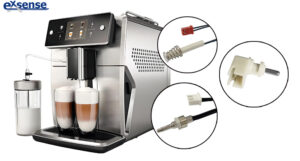NTC Temperature Sensors Unlock the Key to Rich Coffee Aroma
 Water temperature is a critical parameter determining coffee quality and taste at the heart of coffee brewing. Under professional brewing standards, the ideal water temperature for coffee machines is typically stabilized between 92°C and 96°C (the “Goldilocks Zone”). This temperature range optimally extracts flavor compounds from the coffee grounds while avoiding over-extraction or loss of delicate notes. Consequently, precise water temperature control is a core indicator of a coffee machine’s performance.
Water temperature is a critical parameter determining coffee quality and taste at the heart of coffee brewing. Under professional brewing standards, the ideal water temperature for coffee machines is typically stabilized between 92°C and 96°C (the “Goldilocks Zone”). This temperature range optimally extracts flavor compounds from the coffee grounds while avoiding over-extraction or loss of delicate notes. Consequently, precise water temperature control is a core indicator of a coffee machine’s performance.
As the “Temperature Guardian” of coffee machines, NTC temperature sensors are strategically integrated within the equipment. They continuously monitor minute changes in brewing water temperature, feeding real-time signals to the control system for dynamic adjustments. This prevents sudden temperature fluctuations from compromising coffee taste, ensuring every cup releases its optimal flavor profile within a stable thermal environment.
Ⅰ.The Working Principle of Coffee Brewing
Coffee brewing operates through the precise collaboration of several key stages – from water heating and coffee ground extraction to the final beverage presentation, each step being crucial. When the coffee machine activates, its internal heating element (usually a heating plate or rod) heats the water to the set temperature. Once the water stabilizes within the Goldilocks Zone for extraction, the NTC temperature sensor immediately feeds temperature data to the control system. This triggers the next step: the pump pressurizes, delivering temperature-stable hot water precisely onto the ground coffee. Through thorough contact between the water flow and the coffee grounds, flavor compounds are efficiently extracted, culminating in a cup of rich, aromatic, and well-balanced coffee.
Ⅱ.Classification and Function of NTC Temperature Sensors in Coffee Machines
- Heating Plate NTC Temperature Sensor:
The heating plate, installed at the coffee machine’s base, is primarily responsible for direct water heating. The NTC sensor is mounted flush against the center of the coil, providing real-time feedback on the heating temperature. Based on this data, the control board precisely regulates heating power: when the temperature approaches the set upper limit, power is immediately reduced to prevent overheating; when it dips below the lower limit, heating is rapidly boosted. This closed-loop control maintains water temperature consistently within the 92–96°C “Goldilocks Extraction Zone,” preventing scorched bitterness while ensuring full aroma release.
- Steam NTC Temperature Sensor:
In steam pressurization systems, water is heated into high-pressure steam, entering the brew chamber via pipes to extract coffee. The NTC sensor at the steam outlet detects temperature changes within milliseconds. For different coffee styles, the control system can rapidly switch steam temperatures: for instance, lattes require high-temperature steam around 110°C for milk frothing, while Americanos demand hot water around 94°C. With temperature control precision down to ±0.3°C, the NTC ensures the flavor and taste of every cup consistently meet preset standards.
Ⅲ.Precision Selection Guide: Core Criteria for Coffee Machine NTC Temperature Sensors
In building a coffee machine’s temperature control system, selecting the right NTC temperature sensor directly impacts control accuracy and coffee quality. Focus on these core criteria:
- Temperature Range Compatibility:
The NTC sensor’s measurement range must fully cover the coffee machine’s operating temperatures. This ensures accurate capture of temperature variations throughout the process, from cold start to stable brewing, providing comprehensive data support for the control system.
- Matching the Appropriate Accuracy Grade:
Select an NTC grade suitable for the machine’s required temperature control precision, and specifically set the center value of its resistance parameters. For example, when the core control range is 90°C-95°C, prioritize resistance specifications designed for a 90°C-100°C baseline. This ensures high-precision temperature feedback keeps water temperature control errors within acceptable limits.
- Ensuring Long-Term Stability:
The sensor’s performance stability is paramount for sustained, reliable operation. Choose products that have undergone aging tests and can withstand repeated thermal shocks. This avoids control inaccuracies caused by long-term precision drift, guaranteeing the coffee machine consistently maintains stable brewing quality.
Ⅳ. Conclusion
EXSNESE recommends high-thermal-conductivity, high-waterproof, and fast-response NTC temperature sensors to meet the extreme demands of coffee machine temperature control. These sensors monitor water temperature in real-time, ensure precise temperature stability, and perform multiple tasks such as fault warning and energy consumption optimization. While enhancing the flavor of every cup of coffee, they also build a safety barrier for users. It is foreseeable that as coffee machines evolve with intelligence, NTC temperature sensors will transform into even smarter “Temperature Stewards,” continuously driving the industry towards higher quality and enhanced safety.













